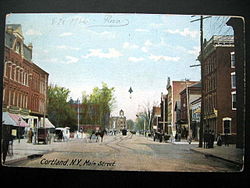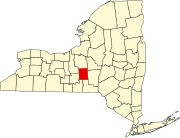Cortland, New York: Difference between revisions
No edit summary |
|||
| Line 113: | Line 113: | ||
In 1868 Cortland became the home of the Cortland Normal School, now the [[State University of New York at Cortland]]. |
In 1868 Cortland became the home of the Cortland Normal School, now the [[State University of New York at Cortland]]. |
||
In 2006, Cortland's historic clock tower burned down. It was later re-built, with spaces for both businesses and apartment style housing.<ref>http://www.9wsyr.com/news/local/story/3rd-anniversary-of-Cortland-clock-tower-fire/B_MkiwVtEkOxYhwyStLFkQ.cspx</ref> |
|||
=== Notable residents === |
=== Notable residents === |
||
Revision as of 19:22, 1 January 2011
Cortland, New York | |
|---|---|
 Downtown Cortland, NY – 1906 | |
| Country | United States |
| State | New York |
| County | Cortland |
| Government | |
| • Type | Mayor-Council |
| • Mayor | Susan Feiszli (D) |
| • Common Council | Members' List |
| Area | |
| • Total | 3.9 sq mi (10.2 km2) |
| • Land | 3.9 sq mi (10.2 km2) |
| • Water | 0.0 sq mi (0.0 km2) |
| Elevation | 1,129 ft (344 m) |
| Population (2000) | |
| • Total | 18,740 |
| • Density | 4,778.6/sq mi (1,845.0/km2) |
| Time zone | UTC-5 (Eastern (EST)) |
| • Summer (DST) | UTC-4 (EDT) |
| ZIP code | 13045 |
| Area code | 607 |
| FIPS code | 36-18388 |
| GNIS feature ID | 0947499 |
Cortland is a city in Cortland County, New York, USA. As of the 2000 census, the city had a population of 18,740. It is the county seat of Cortland CountyTemplate:GR.
The City of Cortland, near the west border of the county, is surrounded by the Town of Cortlandville.
History
The city is within the former Central New York Military Tract. The city is named after Pierre Van Cortlandt the first Lieutenant Governor of the State of New York.
Cortland, settled in 1791, was made a village in 1853 (rechartered in 1864), and was incorporated as a city in 1900 as the 41st city in the State of New York. When the county was formed in 1808, Cortland vied with other villages and won the status of becoming the county seat. The City of Cortland is the county seat of Cortland County. Known as the "Crown City" because of its location on a plain formed by the convergence of seven valleys, Cortland is situated about 1,130 feet (344 m) above sea level, making it the uppermost city to crown the state. Forty stars, representing the 40 cities incorporated before Cortland, circle the State of New York and Crown on the Official City Seal. The seven points of the Crown create seven valleys depicting Cortland's seven surrounding valleys. The 41st star in the center of the Crown illustrates Cortland as the closest incorporated City to the geographic center of New York.
The leading industry in Cortland in the late nineteenth and early twentieth century was the Wickwire Brothers wire drawing mill, noted for its production of wire hardware cloth for use as window screens. The extent of their wealth is commemorated in a pair of magnificent mansions, the Victorian gothic home of Chester Wickwire is now the "1890 House Museum and Center for the Victorian Arts" [1] while the 1912 home of Charles Wickwire is now called the SUNY Cortland Alumni House and is owned and operated by the SUNY Cortland Alumni Association. It is open to the public as well as being used by the Alumni Association to host College related events and house visiting dignitaries.[2].
Cortland was also home to a pioneering truck maker, Brockway. Begun in 1875 as Brockway Carriage Works, it was taken over by Mack in 1956, and survived until 1977. The city continues to host an annual show of Brockway trucks.[3]
Cortland also boasts a classic Octagon house [4]
In 1868 Cortland became the home of the Cortland Normal School, now the State University of New York at Cortland.
In 2006, Cortland's historic clock tower burned down. It was later re-built, with spaces for both businesses and apartment style housing.[5]
Notable residents
- Catherine Bertini, longtime global leader in food aid distribution.
- Carl Carmer, author
- Dan Cleary, Owner of Cortland Beer Company
- William Dillon, composer, lyricist, and vaudevillian.
- Ronnie James Dio, former frontman for Rainbow and Black Sabbath. A street in Cortland is named for him (Dio Way).
- Nancy Duffy, Syracuse news personality and founder of the Syracuse St. Patrick's Day Parade.
- Chester Gillette, convicted of the 1906 murder of his girlfriend, Grace Brown of Cortland, in a highly publicized, and controversial trial. He was executed by electrocution in 1908.
- Nathan Lewis Miller Governor of New York.
- Mark Nauseef, musician
- Alton B. Parker, Democratic candidate for President in 1904.
- Sime Silverman, publisher
- Elmer Ambrose Sperry, prolific inventor who invented gyroscopic compass and held over 400 patents. USS Sperry (AS-12) named after him.
- Raymond Gram Swing, journalist
- Michael C. Antil Sr., 1930's Baking Industry Marketing Innovator – Centennial Chairman
- Samuel Ringgold Ward, African American who escaped enslavement to become an abolitionist, newspaper editor and Congregational minister
- Spiegle Willcox Jazz trombone player, composer, and singer
- Gary Wood NFL quarterback for the New York Giants
- David Feinstein Musician (Feinstein)
- John West Musician, Singer, Guitarist, Composer (ex- Royal Hunt), Feinstein, Yngwie Malmsteen
Geography
Cortland is located at 42°36′2″N 76°10′53″W / 42.60056°N 76.18139°WInvalid arguments have been passed to the {{#coordinates:}} function (42.600658, −76.181284)Template:GR. Cortland lies between Syracuse, New York and Binghamton, New York.
According to the United States Census Bureau, the city has a total area of 3.9 square miles (10.2 km²), of which, 3.9 square miles (10.2 km²) of it is land and 0.04 square miles (0.1 km²) of it (0.51%) is water.
The Tioughnioga River flows southward past the city.
Interstate 81, US Route 11, and New York State Route 281 are north-south highways servicing the city. New York State Route 13 and New York State Route 41 also service the city.
Air service is provided by Cortland County, Chase Field (N03), located west of the city.
Demographics
As of the censusTemplate:GR of 2000, there were 18,740 people, 6,922 households, and 3,454 families residing in the city. The population density was 4,778.6 people per square mile (1,845.8/km²). There were 7,550 housing units at an average density of 1,925.2/sq mi (743.6/km²). The racial makeup of the city was 95.72% White, 1.56% African American, 0.25% Native American, 0.57% Asian, 0.02% Pacific Islander, 0.56% from other races, and 1.33% from two or more races. Hispanic or Latino of any race were 1.72% of the population.
There were 6,922 households out of which 24.8% had children under the age of 18 living with them, 34.7% were married couples living together, 11.4% had a female householder with no husband present, and 50.1% were non-families. 36.0% of all households were made up of individuals and 13.0% had someone living alone who was 65 years of age or older. The average household size was 2.28 and the average family size was 2.95.
In the city the population was spread out with 18.3% under the age of 18, 28.4% from 18 to 24, 23.6% from 25 to 44, 16.8% from 45 to 64, and 12.9% who were 65 years of age or older. The median age was 28 years. For every 100 females there were 88.4 males. For every 100 females age 18 and over, there were 84.5 males.
The median income for a household in the city was $26,478, and the median income for a family was $39,167. Males had a median income of $29,857 versus $21,614 for females. The per capita income for the city was $14,267. About 13.9% of families and 24.7% of the population were below the poverty line, including 24.8% of those under age 18 and 15.2% of those age 65 or over.
Government
This section needs expansion. You can help by adding to it. (March 2009) |
The Government of Cortland consists of a mayor who is elected at large. The city council consists of 8 members. One member is elected from each of the 8 wards.
Sports
In summer 2009, the New York Jets training camp was moved to Cortland from its traditional home in Florham Park, NJ. The team located their operations at the State University of New York, Cortland campus. The camp drew in 34,000 visitors and brought nearly $4.26 million dollars to the local economy[6]. In 2010, the New York Jets signed a 3-year contract with SUNY Cortland to continue their partnership.
See also
References
- ^ The 1890 House Museum
- ^ SUNY(State University of New York) Cortland Alumni House
- ^ Brockway Truck Preservation Association
- ^ Octagon House Inventory
- ^ http://www.9wsyr.com/news/local/story/3rd-anniversary-of-Cortland-clock-tower-fire/B_MkiwVtEkOxYhwyStLFkQ.cspx
- ^ http://www.nj.com/jets/index.ssf/2010/02/ny_jets_and_suny_cortland_nego.html

